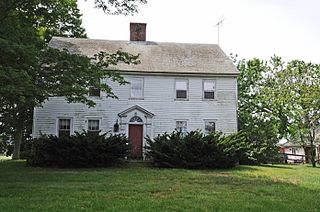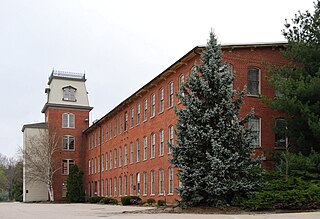
Wakefield is a village in the town of South Kingstown, Rhode Island, United States, and the commercial center of South Kingstown. Together with the village of Peace Dale, it is treated by the U.S. Census as a component of the census-designated place identified as Wakefield-Peacedale, Rhode Island. West Kingston, another South Kingstown village, was the traditional county seat of Washington County. Since 1991, the Washington County Courthouse has been in Wakefield. The Sheriff's Office which handles corrections is also in Wakefield.

Peace Dale is a village in the town of South Kingstown, Rhode Island. Together with the village of Wakefield, it is treated by the U.S. Census as a component of the census-designated place identified as Wakefield-Peacedale, Rhode Island.

Saunderstown is a small village and historic district in the towns of Narragansett and North Kingstown in Washington County, Rhode Island, United States. Its population is 6,245.

Carolina is a village that straddles the border of the towns of Charlestown and Richmond on the Pawcatuck River in Washington County, Rhode Island. Rhode Island Route 112 passes through the village. Carolina is identified as a census-designated place, with a population of 970 at the 2010 census.

The George Fayerweather Blacksmith Shop is an historic homestead and blacksmith shop at 1859 Mooresfield Road on the eastern outskirts of the Kingston Historic District in South Kingstown, Rhode Island. It was the home of George Fayerweather, an African-American blacksmith and his family, including his wife Sarah Harris Fayerweather. The shop was built in 1820 and was added to the National Register of Historic Places in 1984. The property is maintained by the Kingston Improvement Association, a non-profit organization of local residents, and is now the home of the Fayerweather Craft Guild and the Kingston Garden Club.

The Cottrell House is a historic house in South Kingstown, Rhode Island. The house is the centerpiece of a working farm complex which includes 73 acres (30 ha) of land, and is one of South Kingstown's last working farms. The house, built c. 1790, is a fairly typical Federal style structure, 2-1/2 stories tall, five bays wide, with a large central chimney. The main barn, located south of the house, is believed to be contemporary to the house, although it has undergone some alteration and extension in the 20th century.

The Crowfield Historic District is a small residential historic district in North Kingstown, Rhode Island. It encompasses a cluster of four early 20th-century summer houses, all connected via family or friendship connections to the writer Owen Wister. The occupy a large parcel of land sloping down to the shore of Narragansett Bay on the east side of Boston Neck Road, a short way north of the Jamestown Verrazzano Bridge. The area was named "Crowfield" by Elizabeth Middleton Cope, who built a Shingle-style mansion in 1906. Owen Wister, her uncle, built his house, Champ de Corbeau, in 1909-10 to a design by Grant Lafarge. The Jamieson House was also built in 1906, and was designed by the same architect, James P. Jamieson. The fourth house, Orchard House, was built in 1924. All are Shingle style houses. The compound is unusual for North Kingstown, where most summer estates were isolated individual properties.

The Henry Eldred Farm is an historic farm complex at 368 Old North Road in South Kingstown, Rhode Island. The main block of the farmhouse, a 2-1/2 story wood frame structure, was probably built c. 1822, although there is architectural evidence suggesting it may be an enlargement of an older structure. Its simple Federal styling is distinctly rural and vernacular in character. The complex also includes a cluster of buildings dating to the mid-19th century, including a barn, carriage house, shed, and blacksmith shop.

For the Gardencourt Historic District is Louisville Kentucky see Cherokee-Seneca, Louisville

The R.R. Gardner House is a historic house located in South Kingstown, Rhode Island.

The Kingston Hill Farm, also known as the Potter-Peckham Farm, is a historic farm in South Kingstown, Rhode Island. The 20-acre (8.1 ha) farm is centered on a building complex with a c. 1810 1-1/2 story wood frame farmhouse, which follows a typical plan of five bays with a central chimney. Behind the house are a seed barn and wagon shed, both dating to the early 20th century. A family cemetery with 18th-century graves is located near the southern boundary of the property. The farm was first established by William Potter in the 1730s; by the early 18th century it came into the hands of Elisha Reynolds Potter, who operated it as a tenant farm. Potter tore down the original farmhouse and built the now-surviving smaller house.

Lafayette Village is a historic district extending along Ten Rod Road in North Kingstown, Rhode Island. It encompasses a linear rural and industrial village, running from the Wickford Junction railroad crossing in the west to Angel Avenue in the east, and includes a number of residential properties on adjacent side streets. The centerpiece of the district is the Rodman Manufacturing Company complex, which operated here for a century beginning in the 1840s. The Robert Rodman Mansion, a Second Empire house with an elaborate porch, stands at 731 Ten Rod Road, and the Walter Rodman House, built in the 1870s, is even more elaborately decorated. Most of the residential stock in the district is mill-related housing built by the Rodmans for their workers.

The Henry Marchant Farm is an historic farm on South County Trail in rural western South Kingstown, Rhode Island. The main house of the farm is a 2 1⁄2-story wood-frame structure, probably built by Joseph Babcock. Construction is traditionally dated to the 1750s, but architectural evidence suggests it may have been built earlier—possibly between 1720 and 1740. The house has well-preserved vernacular Federal styling, including a main entry framed by Doric pilasters and an entablature. The farmstead includes an early 20th-century barn, a carriage house, and an old privy, as well as the family cemetery of the Marchant family. The property was purchased in 1774-75 by Henry Marchant, a leading Newport merchant and politician.

The William Davis Miller House is an historic estate in the Wakefield village of South Kingstown, Rhode Island. The estate consists of 10.7 acres (4.3 ha) of land, on which stand a substantial house, garage and water tank, all built in the mid-1930s. The property was designed by Providence architect Albert Harkness and built for William Davis Miller and Mary (Chew) Miller. Miller was a social and civic force in Providence, serving as a trustee of Brown University, the Providence Public Libraries, and as president of the Rhode Island Historical Society, and was a longtime friend of Harkness. The Colonial Revival estate Harkness designed for the Millers typifies the type of country estates that were built in Rhode Island in the period.

The Commodore Oliver Perry Farm is an historic farm on United States Route 1 in South Kingstown, Rhode Island. The farm consists of 250 acres (100 ha) of rolling fields and woodlands on the west side of the road. The main farm complex includes a wood-frame house, barn, a caretaker's residence, and a number of other outbuildings, accessed via a winding private lane. The main house, a two-story gambrel-roofed structure, is of uncertain construction date, and is generally dated to either 1785 or 1815. It has been extensively altered, and been the subject of well-meaning but historically problematic restorations in the first half of the 20th century.

The Joseph Pierce Farm is an historic farm at 933 Gilbert Stuart Road in North Kingstown, Rhode Island. It consists of 18 acres (7.3 ha) of land, along with an 18th-century farmhouse and a number of 19th-century outbuildings. The oldest portion of the house, its southern ell, was originally built with a gable roof, but this was extended to the north in the late 18th or early 19th century, and given it present gambrel roof and Federal styling. Later additions in the 19th and 20th centuries gave the house its present cruciform appearance. Outbuildings dating to the 19th century include a barn with attached privy, a toolshed, and a henhouse. The complex is a well-preserved reminder of the area's rural heritage.

The Shady Lea Historic District is a historic district on Shady Lea and Tower Hill Roads in North Kingstown, Rhode Island. It encompasses a predominantly residential linear district extending along Shady Lea Road southward from Tower Hill Road. Most of the houses along Shady Lea Road are mill worker housing built in the 19th century for workers at the mill complex which stands at the edge of the Shady Lea Mill Pond, at the southern end of the district. This area is a well-preserved example of the numerous rural mill complexes which dotted the Rhode Island countryside in the 19th century.

The Spink Farm is a historic farm at 1325 Shermantown Road in North Kingstown, Rhode Island. The only surviving element of the farmstead on this 55-acre (22 ha) farm is the main house, a 2-1/2 story five-bay wood frame structure built in 1798 by Isaac Spink. The house exhibits modest Federal styling, its doorway flanked by small sidelight windows and simple pilasters, and topped by a shallow hood. The interior follows a typical center-chimney plan, with its original Federal period fireplace mantels intact. The house has been extended to the rear by a kitchen ell and porch, both added in the 20th century. The house is one of a small number of 18th-century farmsteads left in the town.

The former Washington County Courthouse is an historic building at 3481 Kingstown Road in South Kingstown, Rhode Island. Built in 1892, it was added to the National Register of Historic Places in 1992 as Washington County Court House.

The David S. Baker Estate, also known as Cedar Spring Farm, consists of a pair of related properties at 51 and 67 Prospect Avenue in the Wickford village of North Kingstown, Rhode Island. David Sherman Baker, Jr., a prominent local lawyer and contender for statewide offices built the house around 1882 with his wife. Members of the Baker family built the Italianate, the older of the two houses, 51 Prospect Avenue, which is a 1 1⁄2 story mansard-roofed that is modest in size but features an elaborate wrap around veranda decorated in fairly elaborated Italianate and Second Empire styling. The house at 67 Prospect is much larger 2 1⁄2 story construction, with a 3 1⁄2 story tower and front veranda, again in eclectic Second Empire style. It is one of the largest houses in Wickford, and was referred to by the family as the "Big House". It is unclear whether Baker built the Big House to accommodate his growing family, or as a venue for functions that were part of his political and social activities.





















